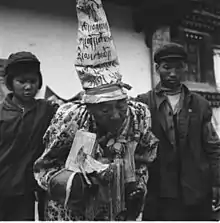Kashopa Chogyal Nyima
Kashopa Chogyal Nyima (tibétain ཀ་ཤོད་པ་ཆོས་རྒྱལ་ཉི་མ, Wylie : ka shod pa chos rgyal nyi ma), appelé Kashopa, de son nom personnel Chogyal Nyima Lhundup (1902 Gyantsé-) est un homme politique tibétain.

| Kalön | |
|---|---|
| - | |
| Membre du comité national de la conférence consultative politique du peuple chinois 6th National Committee of the Chinese People's Political Consultative Conference (d) |
| Naissance | |
|---|---|
| Décès | |
| Nationalités | |
| Activités | |
| Enfant |
Biographie
Né en 1902 à Gyantsé[1], Kashopa Chogyal Nyima est un fonctionnaire laïc de 4e rang[2].
Il entra au service du gouvernement tibétain en 1919[3].
En 1926[4], il fut nommé chikyap (spyi-khyab) de la province de Hor dans le Kham au Tibet oriental, Hor Chi ou commissaire de la province de Hor[2]. Il avait cette fonction en 1927, quand il arrêta les expéditions de Wilhelm Filchner et Nicolas Roerich à Nagchukha[3]. Il laissa cette fonction à Kenchung Dragpa Gyatso en 1929[4].
Il a ensuite travaillé dans l'usine hydro-électrique de Trapchi près de Lhassa[2].
Il devint rimshi en 1934[3], mais après la mort du 13e dalaï-lama, il a été dégradé et emprisonné. La raison n'est pas connue avec certitude[2]. Il a été impliqué dans la conspiration de Lungshar qu'il dévoila au ministre Trimön (en)[3]. Il aussi été accusé d'avoir agi de façon oppressante quand il était responsable de la province de Hor. Une des exigences spécifiques de l'Assemblée nationale datée du était que la plainte de la population de Hor contre lui soit prise en compte. Peu de temps après, il a obtenu sa libération, on pense par corruption, et a été nommé Tsi-pön (chef comptable)[2] en 1935[3].
Il devint un adjoint du responsable de l'usine hydro-électrique de Trapchi en 1941 en plus de ses fonctions de Tsi-pön[2].
Il a été nommé ministre (Shap-pé) le , une fonction qu'il exerça jusqu'en 1949[2].
En 1947, il a été soupçonné de complicité dans la conspiration de Réting Rinpoché[3].
À nouveau emprisonné, il a été libéré de la prison à Lhassa en [2].
Il a été nommé professeur à l'École de langue tibétaine pour les agents chinois en [2].
Il fut réinstallé en tant que fonctionnaire avec le rang de Theiji en [2].

Selon Robert Barnett, Kashopa Chogyal Nyima est considéré comme un collaborateur du régime chinois. La défection de son fils Jamyang Choegyal Kasho, directeur du Tibet Hotel à Lhassa, fut citée dans un discours interne par Chen Kuiyuan en 1997[5].
Publications
- (en) avec Lhalu Tsewang Dorje, The fate of the English school in Lhasa, traduction de K. Dhondup in The water-bird and other years: a history of the Thirteenth Dalai Lama and after, 1986, Rangwang Publishers,
Notes et références
- Michael Rank, Jamyang Choegyal Kasho. In the Service of the 13th and the 14th Dalai Lamas: Choegyal Nyima Lhundrup Kashopa, Asian Affairs, Volume 47, 2016, p. 493-495
- (en) Kapshoba, Tibet Album
- (en) Luciano Petech, Aristocracy and government in Tibet, 1728-1959, Istituto italiano per il Medio ed Estremo Oriente, 1973, p. 88 : « ... to the fore with C'os-rgyal-ni-ma (b. 1903), who entered government service in 1919 and was gSan-rdzon rdzoh-sdod in 1924 3. He held the post of hor-spyi in 1927, when he stopped the Filchner and Roerich expeditions at Nag-c'u-k'a. ... In 1934 he was a rim bzhi, when he became involved in the plot of Lun-sar; he betrayed the conspiracy to bka'- blon K'ri-smon and was formally dismissed, to give an appearance of impartiality to the proceedings; but in 1935 he got his reward, being appointed rtsis-dpon4. In 1945 he was promoted bka'- blon. " In 1947 he was suspected of complicity in the affair of the Rva- sgren Rin-po-c'e conspiracy. »
- (en) Samten Gyaltsen Karmay, The Arrow and the Spindle: Studies in History, Myths, Rituals and Beliefs in Tibet, volume 2, Mandala Publications, 1998, (ISBN 9994655019 et 9789994655014), p. 191
- (en) Robert Barnett, Beyong the collaborator-martyr model, in Contemporary Tibet: Politics, Development, and Society in a Disputed Region, Barry Sautman et June Teufel Dreyer (dir.), voir p. 45 et note 66, p. 60 : « Jamyang Choegyal's father, Kashöpa, a government minister along with Ngapö, had been viewed since the 1950s as the classic Tibetan collaborator] ».
- Portail de la politique
- Portail du Tibet